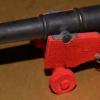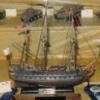-
Posts
1,763 -
Joined
-
Last visited
Reputation Activity
-
 Mark P reacted to mtaylor in Royal Caroline, deck covering
Mark P reacted to mtaylor in Royal Caroline, deck covering
Now you got me wondering if the colors are "intentionally off" as I look at the Wikipedia picture. Note the clouds, the sails, even the flags... everything has a tint to it for the mood... Choppy seas, dark cloud with orangish tint on the white. Storm has just passed or it's nearing sunset.
Boy.. what a mystery.
-
 Mark P got a reaction from mtaylor in HBMS Amphion 1798 by Matrim - 32 Gun 18pdr Frigate
Mark P got a reaction from mtaylor in HBMS Amphion 1798 by Matrim - 32 Gun 18pdr Frigate
Hi Matrim;
thank you for the reply. Everybody develops their own way of working, and if it works well, that's all we need. I thought that you would probably have your own system to avoid confusing frames, as it seems to be necessary. I had not really thought of using a temporary colour change. I'll keep it in mind as it might well be useful for other things.
All the best,
Mark P
-
 Mark P got a reaction from jud in HBMS Amphion 1798 by Matrim - 32 Gun 18pdr Frigate
Mark P got a reaction from jud in HBMS Amphion 1798 by Matrim - 32 Gun 18pdr Frigate
Hi Matrim;
thank you for the reply. Everybody develops their own way of working, and if it works well, that's all we need. I thought that you would probably have your own system to avoid confusing frames, as it seems to be necessary. I had not really thought of using a temporary colour change. I'll keep it in mind as it might well be useful for other things.
All the best,
Mark P
-
 Mark P got a reaction from druxey in Royal Caroline, deck covering
Mark P got a reaction from druxey in Royal Caroline, deck covering
Hi Gentlemen, and thank you for your interest.
Druxey: the carved and gilded frieze of figures is well-detailed on the painting, and is a very close match for the draught of Royal Caroline which was made by Af Chapman, who was in the Deptford area close to the time of her building.
I have also found an itemised bill for decorating the Royal Caroline, which lists Mr Cleveley as responsible for painted panels, of shipping and other themes, in the King's rooms, and for re-furbishing the panel on the buffet, presumably removed from Caroline's predecessor.
It can therefore be a safe assumption that the picture of Royal Caroline painted by John Cleveley, from which the photos above are taken, was painted by him (in 1750) based on a great degree of close personal knowledge of her appearance.
You may also remember some earlier posts about a seat of ease at the beakhead, which is also drawn on Chapman's draught. It is just possible to make this out on the painting, although not clear; however, there is another painting of her by John Cleveley, in which the seat of ease is quite clearly shown.
Fatfingers: thank you for the idea; teak does go silvery over time, as do many other woods left to weather. I am not sure if timber from the Far East was being used at this time, though, in English shipyards, but it is something to consider, and a possible explanation.
A point against this is that the decks were almost certainly scrubbed (swabbed) every day, and at the time of the painting, Royal Caroline was still only months on from being launched, so the decks would not have been very old.
All the best,
Mark P
-
 Mark P reacted to mtaylor in Royal Caroline, deck covering
Mark P reacted to mtaylor in Royal Caroline, deck covering
I did mis-read that, Mark. My bad. If as your last post says it was during the sea trials, you're probably correct... canvas or still not finished.
I'm wondering if was sea trials, that many things were covered to protect them.. not just from the elements but also whatever work needed to be carried out during the trials.
Oh what we would give for a time machine.....
-
 Mark P got a reaction from mtaylor in HBMS Amphion 1798 by Matrim - 32 Gun 18pdr Frigate
Mark P got a reaction from mtaylor in HBMS Amphion 1798 by Matrim - 32 Gun 18pdr Frigate
Hi Matrim;
Excellent draughting!
One thought that might be of interest: when I have been copying/drawing a draught, I make each station line a different colour. Then, when the lines are drawn on the body plan, at the outer edges, where they overlap a lot, it is easier to distinguish which is which. I also make any datum marks on the body plan the same colour as the station line to which they belong.
All the best,
Mark P
-
 Mark P got a reaction from mtaylor in Royal Caroline, deck covering
Mark P got a reaction from mtaylor in Royal Caroline, deck covering
Hi Mark;
I think you slightly mis-read my note, as it says she was months on from being launched, ie after launching.
I will try and avoid such potentially misleading sentences in the future, and make it clearer.
All the best,
Mark P
-
 Mark P got a reaction from Matrim in HBMS Amphion 1798 by Matrim - 32 Gun 18pdr Frigate
Mark P got a reaction from Matrim in HBMS Amphion 1798 by Matrim - 32 Gun 18pdr Frigate
Hi Matrim;
Excellent draughting!
One thought that might be of interest: when I have been copying/drawing a draught, I make each station line a different colour. Then, when the lines are drawn on the body plan, at the outer edges, where they overlap a lot, it is easier to distinguish which is which. I also make any datum marks on the body plan the same colour as the station line to which they belong.
All the best,
Mark P
-
 Mark P got a reaction from mtaylor in Royal Caroline, deck covering
Mark P got a reaction from mtaylor in Royal Caroline, deck covering
Hi Gentlemen, and thank you for your interest.
Druxey: the carved and gilded frieze of figures is well-detailed on the painting, and is a very close match for the draught of Royal Caroline which was made by Af Chapman, who was in the Deptford area close to the time of her building.
I have also found an itemised bill for decorating the Royal Caroline, which lists Mr Cleveley as responsible for painted panels, of shipping and other themes, in the King's rooms, and for re-furbishing the panel on the buffet, presumably removed from Caroline's predecessor.
It can therefore be a safe assumption that the picture of Royal Caroline painted by John Cleveley, from which the photos above are taken, was painted by him (in 1750) based on a great degree of close personal knowledge of her appearance.
You may also remember some earlier posts about a seat of ease at the beakhead, which is also drawn on Chapman's draught. It is just possible to make this out on the painting, although not clear; however, there is another painting of her by John Cleveley, in which the seat of ease is quite clearly shown.
Fatfingers: thank you for the idea; teak does go silvery over time, as do many other woods left to weather. I am not sure if timber from the Far East was being used at this time, though, in English shipyards, but it is something to consider, and a possible explanation.
A point against this is that the decks were almost certainly scrubbed (swabbed) every day, and at the time of the painting, Royal Caroline was still only months on from being launched, so the decks would not have been very old.
All the best,
Mark P
-
 Mark P reacted to FatFingers in Royal Caroline, deck covering
Mark P reacted to FatFingers in Royal Caroline, deck covering
Possibly, if the decks were teak they would go grey with exposure to the elements.
-
 Mark P reacted to druxey in Royal Caroline, deck covering
Mark P reacted to druxey in Royal Caroline, deck covering
It is intriguing to think that the weather decks were covered with heavy canvas druggets, but this is unlikely, as J S Frank suggests. Weathered wood, even if scrubbed would turn a greyish color after a while. While it is tempting to think that the planking was painted 'sad colour', this can also be discounted as it would be difficult to maintain. How accurate, in your opinion, Mark, is the painting in other details?
-
 Mark P reacted to JerseyCity Frankie in Royal Caroline, deck covering
Mark P reacted to JerseyCity Frankie in Royal Caroline, deck covering
I think everyone is going to ask you to provide the image so we can see it. Are you sure you are seeing canvas in the artwork? Actual decks on real ships are a grey color from use and weathering. I have heard of canvas on decks in the great cabins of ships but these are interior spaces and the canvas is painted to look like tile. Canvas underfoot on an exterior deck is something I never heard of or seen before in a painting or a model. And from a feasibility standpoint it does not make much sense to me, its going to wear into rags pretty quickly while at the same time holding moisture in the wood deck. Also, even if painted its going to become absolutely filthy in a short time. Wooden decks were routinely (sometimes daily) hollystoned to keep them looking clean and this is much more likely for a royal yacht, in my opinion.
-
 Mark P got a reaction from reklein in Mid 18th Century glass
Mark P got a reaction from reklein in Mid 18th Century glass
Hello everyone;
I thought that my fellow modellers might be interested in the following document, which I found at the National Archive in England, whilst searching for a somewhat different subject.
This lists the prices, sizes and quantities of a delivery of glass made to Deptford Dockyard in November 1750.
The biggest pieces are quite large: 31" x 21 1/2", 3no. Their rarity and value is reflected in their price, £7.0.0 each, which is many times higher than the smaller, more numerous pieces.
Lower down in the list are some pieces of mirrored (silvered) glass, some of which are again quite large and expensive.
Clicking on the image should make it larger. If not, right-clicking on the image should bring up a menu with an option to 'open image in new window' option which makes it larger and easier to read.
All the best,
Mark P
-
 Mark P reacted to wefalck in Mid 18th Century glass
Mark P reacted to wefalck in Mid 18th Century glass
Indeed, the bull's eye-glass (or 'Butzen' in German) has been very common and is used in 'romantic' reconstructions of medieval windows. However, considering that there only two bull's eyes coming out of each cylinder and only one from each disc, there must have been a considerable production of plate glass to give sufficient numbers of them for a window. I guess, from the mid-19th century on, they were not only 'waste' products anymore, but made specifically to meet medieval-revival demands. Also, in Germany the 'Butzen' often are 'bottle-green', indicating that inferior quality raw materials with a lot of metal contaminants were used - so the associated flat glass must have also been green.
Here is an image from Wikipedia that shows the production of disc-glass in the 'forest' ('en bois', because they needed the wood for fuel):
If I am not mistaken, sometime in the last quarter of the 19th century the float-glass was inventend in France, whereby the the near-liquid glass was poured onto a bassin with mercury. Indeed, France seems to have been technologically ahead in glass production for quite some time.
-
 Mark P got a reaction from EJ_L in Mid 18th Century glass
Mark P got a reaction from EJ_L in Mid 18th Century glass
Hello everyone;
I thought that my fellow modellers might be interested in the following document, which I found at the National Archive in England, whilst searching for a somewhat different subject.
This lists the prices, sizes and quantities of a delivery of glass made to Deptford Dockyard in November 1750.
The biggest pieces are quite large: 31" x 21 1/2", 3no. Their rarity and value is reflected in their price, £7.0.0 each, which is many times higher than the smaller, more numerous pieces.
Lower down in the list are some pieces of mirrored (silvered) glass, some of which are again quite large and expensive.
Clicking on the image should make it larger. If not, right-clicking on the image should bring up a menu with an option to 'open image in new window' option which makes it larger and easier to read.
All the best,
Mark P
-
 Mark P got a reaction from Jolley Roger in Mid 18th Century glass
Mark P got a reaction from Jolley Roger in Mid 18th Century glass
Hello everyone;
I thought that my fellow modellers might be interested in the following document, which I found at the National Archive in England, whilst searching for a somewhat different subject.
This lists the prices, sizes and quantities of a delivery of glass made to Deptford Dockyard in November 1750.
The biggest pieces are quite large: 31" x 21 1/2", 3no. Their rarity and value is reflected in their price, £7.0.0 each, which is many times higher than the smaller, more numerous pieces.
Lower down in the list are some pieces of mirrored (silvered) glass, some of which are again quite large and expensive.
Clicking on the image should make it larger. If not, right-clicking on the image should bring up a menu with an option to 'open image in new window' option which makes it larger and easier to read.
All the best,
Mark P
-
 Mark P reacted to druxey in Mid 18th Century glass
Mark P reacted to druxey in Mid 18th Century glass
This is in accord with what I've read elsewhere. Large 'blown plate' aka 'ground glass' was made by grinding and polishing 'broadsheet glass'. This accounts for its expense. Large pieces were principally used in coaches and for mirrors.
Nice find, Mark!
-
 Mark P reacted to mtaylor in Mid 18th Century glass
Mark P reacted to mtaylor in Mid 18th Century glass
I like the line at the bottom.. "We are humbly of the opinion the prices he asks are reasonable". Big pieces would have priced higher given the state of the art of glass making back then.
Thanks for posting this.
-
 Mark P got a reaction from CaptainSteve in Mid 18th Century glass
Mark P got a reaction from CaptainSteve in Mid 18th Century glass
Hello everyone;
I thought that my fellow modellers might be interested in the following document, which I found at the National Archive in England, whilst searching for a somewhat different subject.
This lists the prices, sizes and quantities of a delivery of glass made to Deptford Dockyard in November 1750.
The biggest pieces are quite large: 31" x 21 1/2", 3no. Their rarity and value is reflected in their price, £7.0.0 each, which is many times higher than the smaller, more numerous pieces.
Lower down in the list are some pieces of mirrored (silvered) glass, some of which are again quite large and expensive.
Clicking on the image should make it larger. If not, right-clicking on the image should bring up a menu with an option to 'open image in new window' option which makes it larger and easier to read.
All the best,
Mark P
-
 Mark P got a reaction from mtaylor in Mid 18th Century glass
Mark P got a reaction from mtaylor in Mid 18th Century glass
Hello everyone;
I thought that my fellow modellers might be interested in the following document, which I found at the National Archive in England, whilst searching for a somewhat different subject.
This lists the prices, sizes and quantities of a delivery of glass made to Deptford Dockyard in November 1750.
The biggest pieces are quite large: 31" x 21 1/2", 3no. Their rarity and value is reflected in their price, £7.0.0 each, which is many times higher than the smaller, more numerous pieces.
Lower down in the list are some pieces of mirrored (silvered) glass, some of which are again quite large and expensive.
Clicking on the image should make it larger. If not, right-clicking on the image should bring up a menu with an option to 'open image in new window' option which makes it larger and easier to read.
All the best,
Mark P
-
 Mark P got a reaction from ScottRC in Mid 18th Century glass
Mark P got a reaction from ScottRC in Mid 18th Century glass
Hello everyone;
I thought that my fellow modellers might be interested in the following document, which I found at the National Archive in England, whilst searching for a somewhat different subject.
This lists the prices, sizes and quantities of a delivery of glass made to Deptford Dockyard in November 1750.
The biggest pieces are quite large: 31" x 21 1/2", 3no. Their rarity and value is reflected in their price, £7.0.0 each, which is many times higher than the smaller, more numerous pieces.
Lower down in the list are some pieces of mirrored (silvered) glass, some of which are again quite large and expensive.
Clicking on the image should make it larger. If not, right-clicking on the image should bring up a menu with an option to 'open image in new window' option which makes it larger and easier to read.
All the best,
Mark P
-
 Mark P reacted to Q A's Revenge in A Lorch Micro-Mill that never was ...
Mark P reacted to Q A's Revenge in A Lorch Micro-Mill that never was ...
I'd like one of these, a fully functional miniature Bridgeport!
-
 Mark P reacted to Jim Lad in Triple blocks reeving sequence
Mark P reacted to Jim Lad in Triple blocks reeving sequence
John,
If all else fails, just try Googling 'reeving threefold purchase' - it should come up in the search.
John
-
 Mark P reacted to Jim Lad in Triple blocks reeving sequence
Mark P reacted to Jim Lad in Triple blocks reeving sequence
John, in rigging a threefold purchase it is common to lead the hauling part of the rope through the centre sheave first in order to even out the stress on the block shell. This video on YouTube may be of help:- htpps://www.youtube.com/watch?v=HXibVitpnRo
John
-
 Mark P got a reaction from mtaylor in Ratlines-What knot do you use on the ends? And how do you trim off the thread?
Mark P got a reaction from mtaylor in Ratlines-What knot do you use on the ends? And how do you trim off the thread?
Hi Keith;
I think you will find that in the days of sailing vessels a clove hitch was used where the ratlines crossed the inner shrouds, but an eye-splice was formed in each end and this was seized to the outermost shrouds.
All the best,
Mark P











